Unit 1 Cultural relics Grammar非限制性定语从句(26张)
文档属性
| 名称 | Unit 1 Cultural relics Grammar非限制性定语从句(26张) |  | |
| 格式 | zip | ||
| 文件大小 | 2.6MB | ||
| 资源类型 | 教案 | ||
| 版本资源 | 人教版(新课程标准) | ||
| 科目 | 英语 | ||
| 更新时间 | 2018-07-16 21:41:54 | ||
图片预览



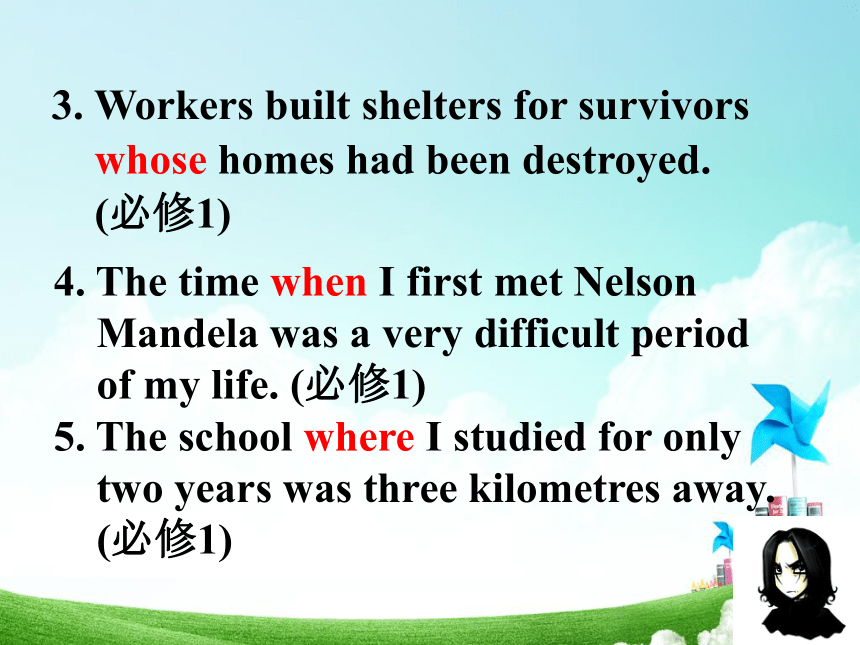
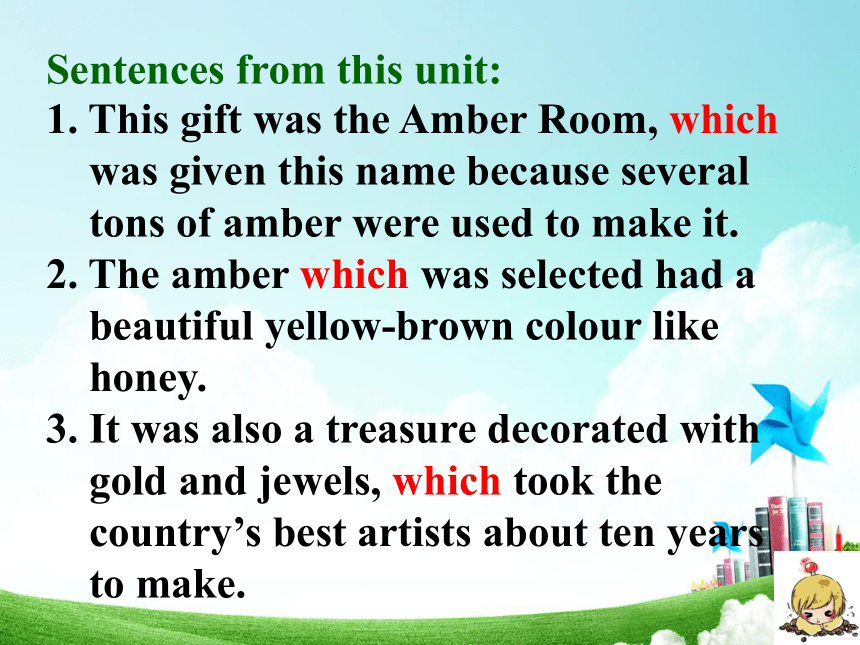
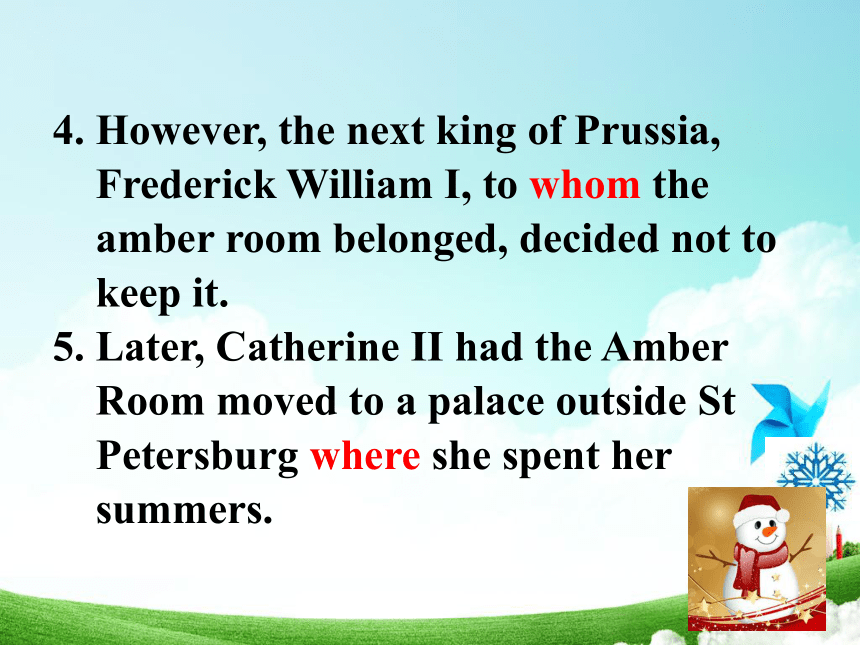
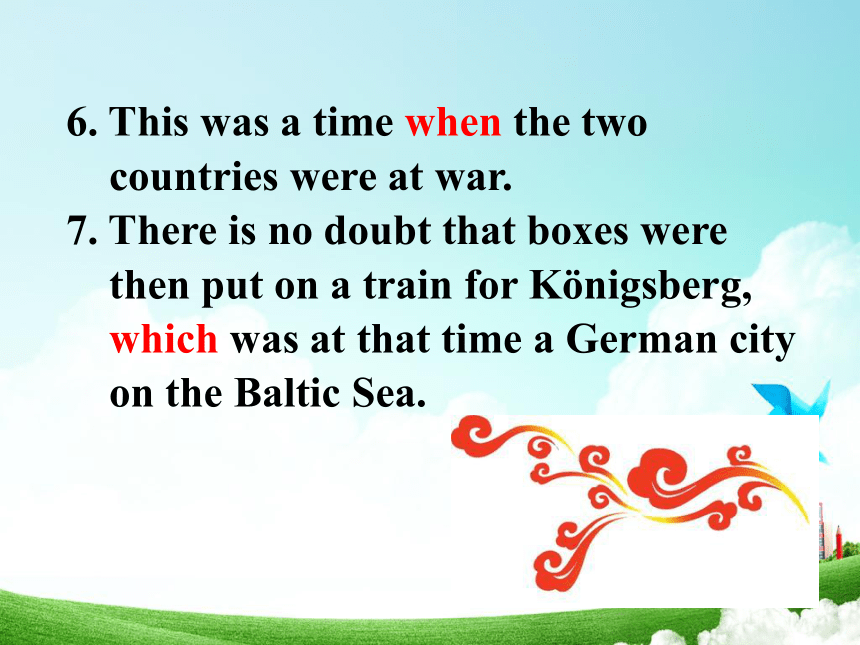

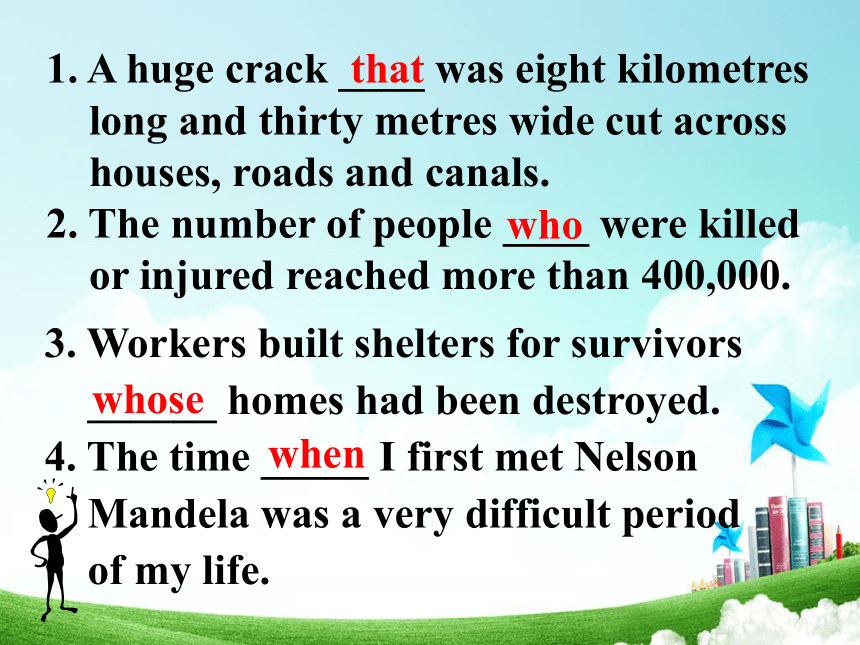
文档简介
课件26张PPT。 The Restrictive and
Non-Restrictive Attributive ClauseUnit 1 GrammarTo tell the difference between the restrictive and non-restrictive attributive clause and be able to use them properlyLook at the following sentences.1. A huge crack that was eight
kilometres long and thirty metres
wide cut across houses, roads and
canals. (必修1)
2. The number of people who were
killed or injured reached more than
400,000. (必修1)Have a look3. Workers built shelters for survivors
whose homes had been destroyed.
(必修1)4. The time when I first met Nelson
Mandela was a very difficult period
of my life. (必修1)
5. The school where I studied for only
two years was three kilometres away.
(必修1)1. This gift was the Amber Room, which
was given this name because several
tons of amber were used to make it.
2. The amber which was selected had a
beautiful yellow-brown colour like
honey.
3. It was also a treasure decorated with
gold and jewels, which took the
country’s best artists about ten years
to make.Sentences from this unit:4. However, the next king of Prussia,
Frederick William I, to whom the
amber room belonged, decided not to
keep it.
5. Later, Catherine II had the Amber
Room moved to a palace outside St
Petersburg where she spent her
summers.6. This was a time when the two
countries were at war.
7. There is no doubt that boxes were
then put on a train for K?nigsberg,
which was at that time a German city
on the Baltic Sea. 1. to test your sense of observation
2. to test your ability of short-term memory
3. to test your ability to highlight the language pointsGuessing Game1. A huge crack ____ was eight kilometres
long and thirty metres wide cut across
houses, roads and canals.
2. The number of people ____ were killed
or injured reached more than 400,000. thatwho3. Workers built shelters for survivors
______ homes had been destroyed.
4. The time _____ I first met Nelson
Mandela was a very difficult period
of my life. whosewhen6. This was a time ______ the two
countries were at war.
7. There is no doubt that boxes were
then put on a train for K?nigsberg,
______ was at that time a German
city on the Baltic Sea.whenwhich5. The school ______ I studied for only
two years was three kilometres away. where8. This gift was the Amber Room, _____
was given this name because several
tons of amber were used to make it.
9. The amber ______ was selected had a
beautiful yellow-brown colour like
honey.
10. It was also a treasure decorated with
gold and jewels, ______ took the
country’s best artists about ten years
to make.whichwhichwhich11. However, the next king of Prussia,
Frederick William I, ________ the
amber room belonged, decided not to
keep it.
12. Later, Catherine II had the Amber
Room moved to a palace outside St
Petersburg ______ she spent her
summers.to whomwhereWhat is attributive clause?An attributive clause tells us which person or thing (or what person or thing) the speaker meansThe woman who lives next door is a doctor.“who lives next door” tells us which womanWe know a lot of people who live in London.“who live in London” tells us what kind of peopleattributive clauseMy brother Jim, who lives in London, is a doctor.
Colin told me about his new job, which he’s enjoying very much.
We stayed at the Grand Hotel, which Ann recommended to us.Non-restrictive are used to add _______________ about a noun or pronoun, but this information is (necessary/not necessary) to explain which person or thing we mean.extra informationnon-restrictive clauses√Notice that we put a comma between the noun and a non-restrictive clause, and another comma at the end of this clause if it is not the end of a sentence.定语从句Attributive Clauses在复合句中,如作定语的是一个从句,该从句被称为定语从句。The boy who is wearing a black coat bought an iPod yesterday.Anyway, that?evening, which I'll?tell?you more about?later, I ended?up?staying?at Rachel's place. 主语定语从句定语从句主语修饰the boy修饰evening定语从句的种类Mum, this is Kate, who I knew in Paris.Shanghai is a city (that) I’ve always wanted to visit.限制性定语从句非限制性定语从句限制性定语中,从句是先行词在意义上不可缺少的定语。如果关系代词在限定性定语从句中作宾语,关系代词通常可以省略。非限制性定语从句只是对先行词作附加补充说明。从句和主句在书写时往往用逗号分开。限制性定语从句和非限制性定语从句的区别用逗号与主句隔开。 只是对先行词的补充说明,如删除,主句仍能表达完整的意思。限制性定语从句和非限制性定语从句的区别通常译成主句的并列句1.不可省略 2.不用that3.不可用who代替whom注意He often comes to school late, which makes his teacher angry.She eats too much, which makes her fatter and fatter.I had told them the reason, for which I didn't attend the meeting. Do you know Tom, whom we talked about?注意whose的用法Do you know Peter whose father happens to be working in your company?Xi’an, whose walls remain as good as before, is one of the few cities with city walls.你认识彼得吗?他的父亲恰巧在你们公司工作。西安是少数几座有城墙的城市之一,它的城墙保持得和以前一样好。whose是who的所有格形式,可以指代人或物。当指代物时,相当于of which,whose可以引导限制性定语从句和非限制性定语从句。1. The famous basketball star, ____ is an American, came to China yesterday.
2. They are always smoking, _____, of course, will do harm to their health.
3. I bought a car yesterday, _____ cost me a lot.whichwhichwhoQuiz I: Fill in the blanks with proper
relative words.4. Xi’an, ______ I visited last year, is a nice old city.
5. He will come to see me next July, _____ he won’t be so busy.
6. The school, ______ I once studied, was built thirty years ago.whichwherewhenQuiz II: Complete the passage with relative pronouns and adverbs.wherewhosewhichwhosewhichwhichwhowhichwhenwhyHomeworkFinish exercise 1 on
page 43 in your Workbooks.
2. Finish the Exercises
of the Grammar
part in Learning
English.
Non-Restrictive Attributive ClauseUnit 1 GrammarTo tell the difference between the restrictive and non-restrictive attributive clause and be able to use them properlyLook at the following sentences.1. A huge crack that was eight
kilometres long and thirty metres
wide cut across houses, roads and
canals. (必修1)
2. The number of people who were
killed or injured reached more than
400,000. (必修1)Have a look3. Workers built shelters for survivors
whose homes had been destroyed.
(必修1)4. The time when I first met Nelson
Mandela was a very difficult period
of my life. (必修1)
5. The school where I studied for only
two years was three kilometres away.
(必修1)1. This gift was the Amber Room, which
was given this name because several
tons of amber were used to make it.
2. The amber which was selected had a
beautiful yellow-brown colour like
honey.
3. It was also a treasure decorated with
gold and jewels, which took the
country’s best artists about ten years
to make.Sentences from this unit:4. However, the next king of Prussia,
Frederick William I, to whom the
amber room belonged, decided not to
keep it.
5. Later, Catherine II had the Amber
Room moved to a palace outside St
Petersburg where she spent her
summers.6. This was a time when the two
countries were at war.
7. There is no doubt that boxes were
then put on a train for K?nigsberg,
which was at that time a German city
on the Baltic Sea. 1. to test your sense of observation
2. to test your ability of short-term memory
3. to test your ability to highlight the language pointsGuessing Game1. A huge crack ____ was eight kilometres
long and thirty metres wide cut across
houses, roads and canals.
2. The number of people ____ were killed
or injured reached more than 400,000. thatwho3. Workers built shelters for survivors
______ homes had been destroyed.
4. The time _____ I first met Nelson
Mandela was a very difficult period
of my life. whosewhen6. This was a time ______ the two
countries were at war.
7. There is no doubt that boxes were
then put on a train for K?nigsberg,
______ was at that time a German
city on the Baltic Sea.whenwhich5. The school ______ I studied for only
two years was three kilometres away. where8. This gift was the Amber Room, _____
was given this name because several
tons of amber were used to make it.
9. The amber ______ was selected had a
beautiful yellow-brown colour like
honey.
10. It was also a treasure decorated with
gold and jewels, ______ took the
country’s best artists about ten years
to make.whichwhichwhich11. However, the next king of Prussia,
Frederick William I, ________ the
amber room belonged, decided not to
keep it.
12. Later, Catherine II had the Amber
Room moved to a palace outside St
Petersburg ______ she spent her
summers.to whomwhereWhat is attributive clause?An attributive clause tells us which person or thing (or what person or thing) the speaker meansThe woman who lives next door is a doctor.“who lives next door” tells us which womanWe know a lot of people who live in London.“who live in London” tells us what kind of peopleattributive clauseMy brother Jim, who lives in London, is a doctor.
Colin told me about his new job, which he’s enjoying very much.
We stayed at the Grand Hotel, which Ann recommended to us.Non-restrictive are used to add _______________ about a noun or pronoun, but this information is (necessary/not necessary) to explain which person or thing we mean.extra informationnon-restrictive clauses√Notice that we put a comma between the noun and a non-restrictive clause, and another comma at the end of this clause if it is not the end of a sentence.定语从句Attributive Clauses在复合句中,如作定语的是一个从句,该从句被称为定语从句。The boy who is wearing a black coat bought an iPod yesterday.Anyway, that?evening, which I'll?tell?you more about?later, I ended?up?staying?at Rachel's place. 主语定语从句定语从句主语修饰the boy修饰evening定语从句的种类Mum, this is Kate, who I knew in Paris.Shanghai is a city (that) I’ve always wanted to visit.限制性定语从句非限制性定语从句限制性定语中,从句是先行词在意义上不可缺少的定语。如果关系代词在限定性定语从句中作宾语,关系代词通常可以省略。非限制性定语从句只是对先行词作附加补充说明。从句和主句在书写时往往用逗号分开。限制性定语从句和非限制性定语从句的区别用逗号与主句隔开。 只是对先行词的补充说明,如删除,主句仍能表达完整的意思。限制性定语从句和非限制性定语从句的区别通常译成主句的并列句1.不可省略 2.不用that3.不可用who代替whom注意He often comes to school late, which makes his teacher angry.She eats too much, which makes her fatter and fatter.I had told them the reason, for which I didn't attend the meeting. Do you know Tom, whom we talked about?注意whose的用法Do you know Peter whose father happens to be working in your company?Xi’an, whose walls remain as good as before, is one of the few cities with city walls.你认识彼得吗?他的父亲恰巧在你们公司工作。西安是少数几座有城墙的城市之一,它的城墙保持得和以前一样好。whose是who的所有格形式,可以指代人或物。当指代物时,相当于of which,whose可以引导限制性定语从句和非限制性定语从句。1. The famous basketball star, ____ is an American, came to China yesterday.
2. They are always smoking, _____, of course, will do harm to their health.
3. I bought a car yesterday, _____ cost me a lot.whichwhichwhoQuiz I: Fill in the blanks with proper
relative words.4. Xi’an, ______ I visited last year, is a nice old city.
5. He will come to see me next July, _____ he won’t be so busy.
6. The school, ______ I once studied, was built thirty years ago.whichwherewhenQuiz II: Complete the passage with relative pronouns and adverbs.wherewhosewhichwhosewhichwhichwhowhichwhenwhyHomeworkFinish exercise 1 on
page 43 in your Workbooks.
2. Finish the Exercises
of the Grammar
part in Learning
English.
